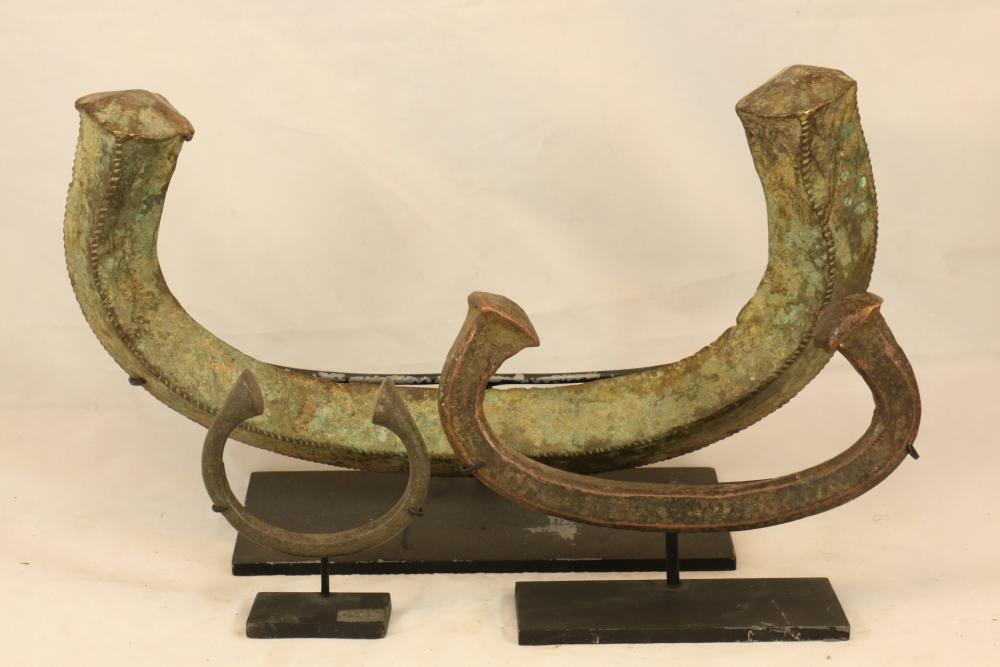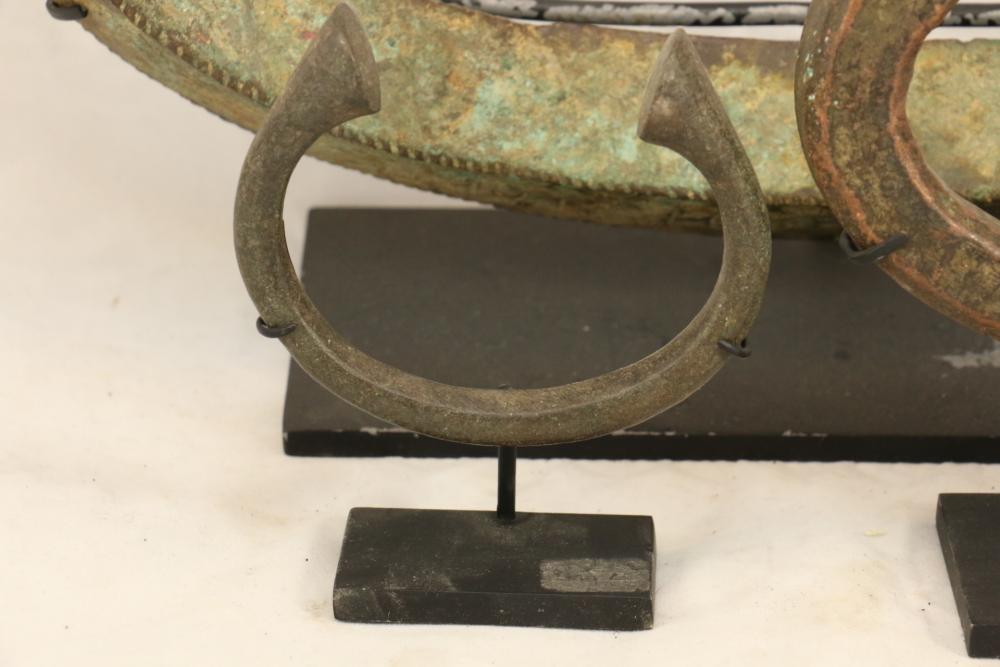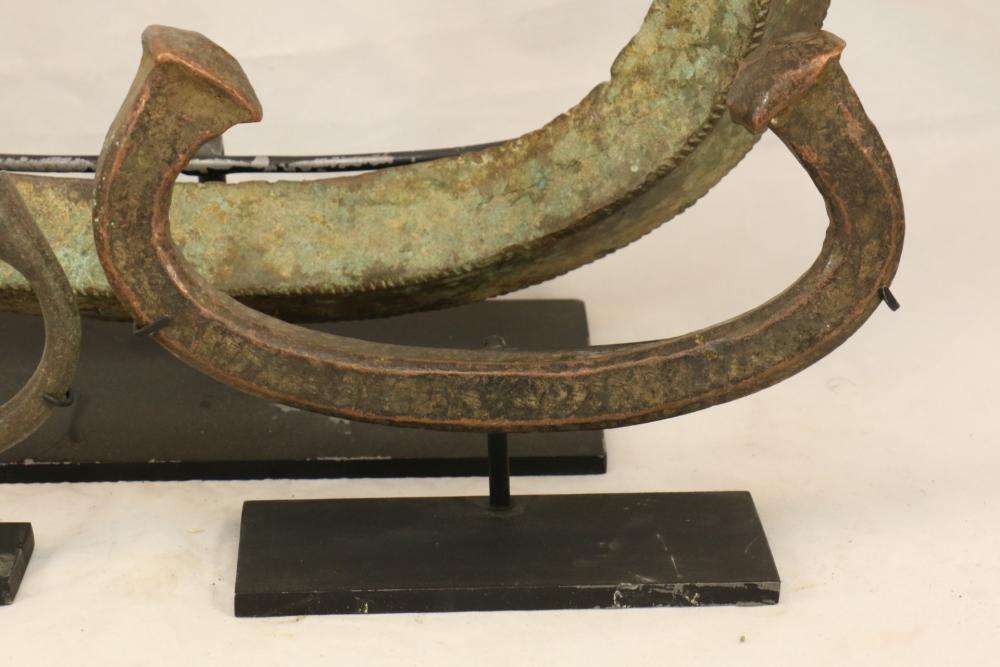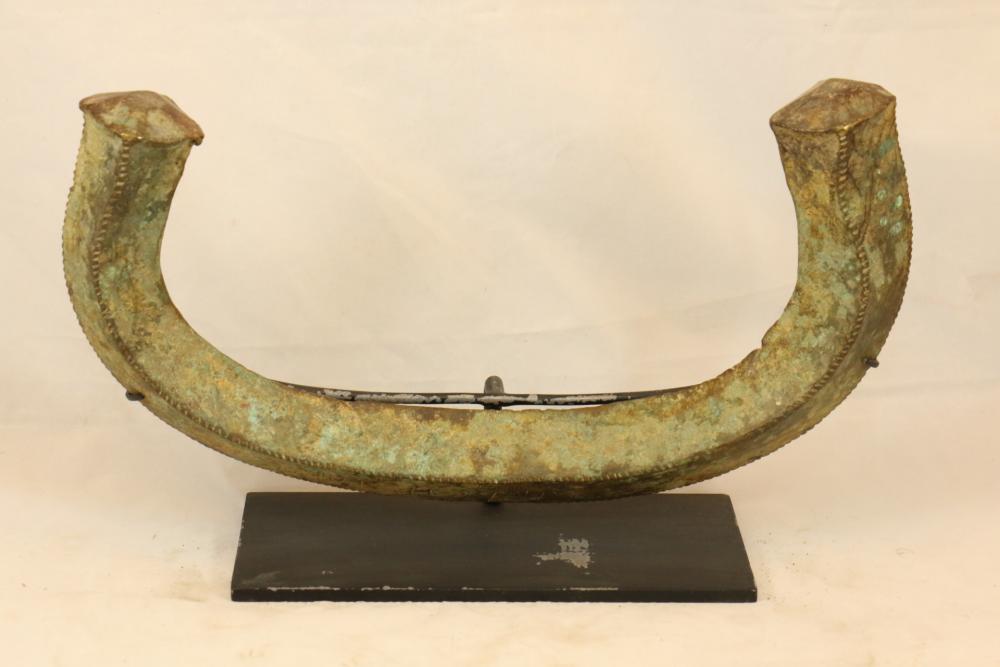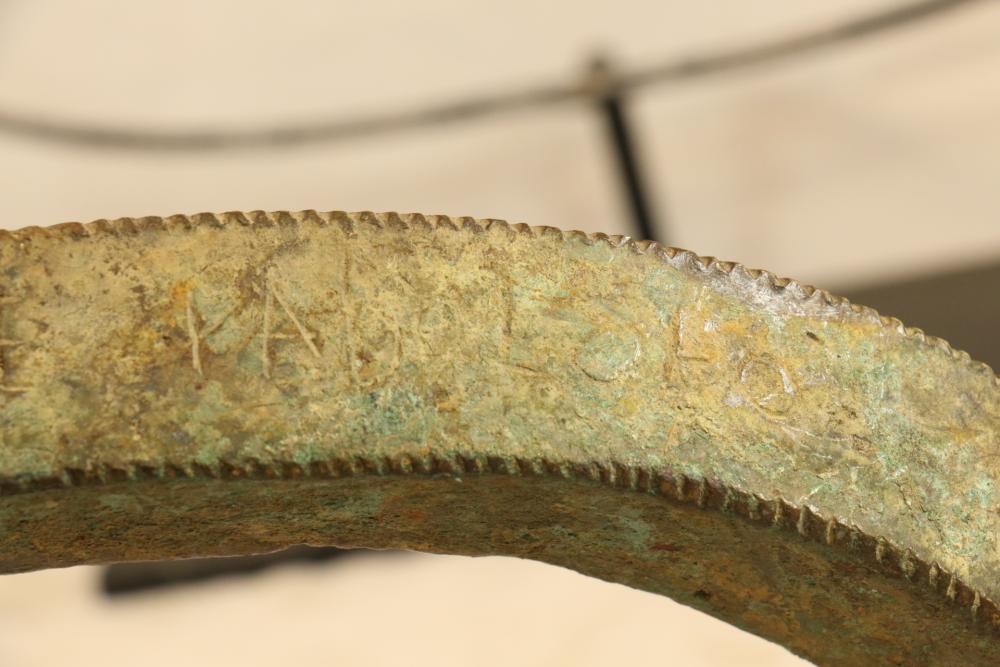Items located in Pleasant Valley, NY. Items include Prestige door (Mgboezi). Igbo people, Nigeria; twisted penny currency bundles. Kissi people, Guinea/Liberia/Ivory Coast; rare Aron Arabai chieftancy mask. Temne people, Sierra Leone; dramatic winged Iler (Hilaire) hoe. Onghai people, Niger & Mali; animal goldweights, Gold Coast (Ghana & Ivory Coast); unusual West African bracelets. (A) Dogon people, Mali and more.
AFRICAN ART COLLECTION OF MARY SUE AND PAUL PETER ROSEN
Mary Sue and Paul Peter Rosen have collected African art for over thirty years, making nine trips to Africa to study the art in its cultural setting. The Rosens have published three African art books, curated more than ten exhibitions from their collection, and have given public lectures about African art and culture. They have donated art from their collection to various institutions including the Newark Museum, Temple University in Philadelphia, the SMA Fathers African Art Museum in Tenafly, New Jersey, and the African American Research Library in Fort Lauderdale, Florida.
Payment is due by Friday, February 21 at 1PM.
Pickup in Pleasant Valley, NY must be completed by Friday, February 21 at 3PM.
All lots sold as is, where is. There is a 15% Buyers Premium for all lots purchased. Payment methods for non-vehicles & non-equipment include cash, MC, Visa, Discover or good check. Payment method for vehicles & equipment is cash, cashiers check, money order or wire transfer only, no exceptions. You can make credit card payment online by going to "My Account" and selecting your invoice.
Preview available Monday-Friday 9am-3pm by appointment only or online 24 hours.
Items are located at The Absolute Auction Center, 45 South Ave. Pleasant Valley, NY 12569. Use this link to get directions to the Absolute Auction Center: http://mapq.st/2zmOD0b
*NOTE* Shipping is available on all items with proper documentation
Click More Info/Bid Now for additional photos.
AFRICAN ART COLLECTION OF MARY SUE AND PAUL PETER ROSEN
Mary Sue and Paul Peter Rosen have collected African art for over thirty years, making nine trips to Africa to study the art in its cultural setting. The Rosens have published three African art books, curated more than ten exhibitions from their collection, and have given public lectures about African art and culture. They have donated art from their collection to various institutions including the Newark Museum, Temple University in Philadelphia, the SMA Fathers African Art Museum in Tenafly, New Jersey, and the African American Research Library in Fort Lauderdale, Florida.
Payment is due by Friday, February 21 at 1PM.
Pickup in Pleasant Valley, NY must be completed by Friday, February 21 at 3PM.
All lots sold as is, where is. There is a 15% Buyers Premium for all lots purchased. Payment methods for non-vehicles & non-equipment include cash, MC, Visa, Discover or good check. Payment method for vehicles & equipment is cash, cashiers check, money order or wire transfer only, no exceptions. You can make credit card payment online by going to "My Account" and selecting your invoice.
Preview available Monday-Friday 9am-3pm by appointment only or online 24 hours.
Items are located at The Absolute Auction Center, 45 South Ave. Pleasant Valley, NY 12569. Use this link to get directions to the Absolute Auction Center: http://mapq.st/2zmOD0b
*NOTE* Shipping is available on all items with proper documentation
Click More Info/Bid Now for additional photos.
Auction Info
Items located in Pleasant Valley, NY. Items include Prestige door (Mgboezi). Igbo people, Nigeria; twisted penny currency bundles. Kissi people, Guinea/Liberia/Ivory Coast; rare Aron Arabai chieftancy mask. Temne people, Sierra Leone; dramatic winged Iler (Hilaire) hoe. Onghai people, Niger & Mali; animal goldweights, Gold Coast (Ghana & Ivory Coast); unusual West African bracelets. (A) Dogon people, Mali and more.
AFRICAN ART COLLECTION OF MARY SUE AND PAUL PETER ROSEN
Mary Sue and Paul Peter Rosen have collected African art for over thirty years, making nine trips to Africa to study the art in its cultural setting. The Rosens have published three African art books, curated more than ten exhibitions from their collection, and have given public lectures about African art and culture. They have donated art from their collection to various institutions including the Newark Museum, Temple University in Philadelphia, the SMA Fathers African Art Museum in Tenafly, New Jersey, and the African American Research Library in Fort Lauderdale, Florida.
Payment is due by Friday, February 21 at 1PM.
Pickup in Pleasant Valley, NY must be completed by Friday, February 21 at 3PM.
All lots sold as is, where is. There is a 15% Buyers Premium for all lots purchased. Payment methods for non-vehicles & non-equipment include cash, MC, Visa, Discover or good check. Payment method for vehicles & equipment is cash, cashiers check, money order or wire transfer only, no exceptions. You can make credit card payment online by going to "My Account" and selecting your invoice.
Preview available Monday-Friday 9am-3pm by appointment only or online 24 hours.
Items are located at The Absolute Auction Center, 45 South Ave. Pleasant Valley, NY 12569. Use this link to get directions to the Absolute Auction Center: http://mapq.st/2zmOD0b
*NOTE* Shipping is available on all items with proper documentation
Click More Info/Bid Now for additional photos.
AFRICAN ART COLLECTION OF MARY SUE AND PAUL PETER ROSEN
Mary Sue and Paul Peter Rosen have collected African art for over thirty years, making nine trips to Africa to study the art in its cultural setting. The Rosens have published three African art books, curated more than ten exhibitions from their collection, and have given public lectures about African art and culture. They have donated art from their collection to various institutions including the Newark Museum, Temple University in Philadelphia, the SMA Fathers African Art Museum in Tenafly, New Jersey, and the African American Research Library in Fort Lauderdale, Florida.
Payment is due by Friday, February 21 at 1PM.
Pickup in Pleasant Valley, NY must be completed by Friday, February 21 at 3PM.
All lots sold as is, where is. There is a 15% Buyers Premium for all lots purchased. Payment methods for non-vehicles & non-equipment include cash, MC, Visa, Discover or good check. Payment method for vehicles & equipment is cash, cashiers check, money order or wire transfer only, no exceptions. You can make credit card payment online by going to "My Account" and selecting your invoice.
Preview available Monday-Friday 9am-3pm by appointment only or online 24 hours.
Items are located at The Absolute Auction Center, 45 South Ave. Pleasant Valley, NY 12569. Use this link to get directions to the Absolute Auction Center: http://mapq.st/2zmOD0b
*NOTE* Shipping is available on all items with proper documentation
Click More Info/Bid Now for additional photos.
Categories:
THREE EXAMPLES OF WEST AFRICAN MANILLA CURRENCY. Manillas are a diverse group of iron, copper, and brass forms of African currency. Origin of the term manilla has been attributed to manilho or manillio, said to refer to bracelet in Portuguese and Spanish. Manillas have semi-circular C-shapes, U- or elongated U-shapes, as well as ring and coiled forms. The majority of manillas used in Africa were of European origin, but some were also produced by Africans, especially in the Congo. The major European sources of manillas were the Portuguese, the English who brought Birmingham manillas, the French who brought ?popo? manillas cast in Nantes, and the Dutch with manillas made in Amsterdam. Larger manillas were classified by the British and other Europeans according to size and weight as King, Queen, and Prince manillas. Manillas were accepted by Africans in trade for a vast variety of goods which Europeans shipped back to their countries, including slaves. Manillas were also used as currency by Africans in major transactions such as bride price, as prestige items (often placed in tombs), and as a store of wealth. This was especially true for ?King? and ?Queen? manillas which frequently were decorated with engraved designs, inscriptions, or the owner?s name and hidden or buried to protect them. Each on custom base. (A) British C-form ?okpoho? manilla from Birmingham with flared feet. Late 18th century. Exported to Calabar region of Nigeria. Copper alloy. Width 3.5in. Weight 5.2oz.(B) Extended U-form ?Prince? manilla with faceted cross-section and faceted, square feet. Exported to Congo from Belgium in the 18th century. Copper. Width 7.5in. Weight 2lb. (C) ?King? extended U-form manilla with quadrilateral cross-section. Spiral designs along 3 of the 4 edges. One surface has an inscription or name engraved in capital English letters. Imported from Britain in the 18th century and excavated from a stash of manillas in central Nigeria. Square faced feet. Width 13.5in. Weight 11lb.
More Details
THREE EXAMPLES OF WEST AFRICAN MANILLA CURRENCY. Manillas are a diverse group of iron, copper, and brass forms of African currency. Origin of the term manilla has been attributed to manilho or manillio, said to refer to bracelet in Portuguese and Spanish. Manillas have semi-circular C-shapes, U- or elongated U-shapes, as well as ring and coiled forms. The majority of manillas used in Africa were of European origin, but some were also produced by Africans, especially in the Congo. The major European sources of manillas were the Portuguese, the English who brought Birmingham manillas, the French who brought ?popo? manillas cast in Nantes, and the Dutch with manillas made in Amsterdam. Larger manillas were classified by the British and other Europeans according to size and weight as King, Queen, and Prince manillas. Manillas were accepted by Africans in trade for a vast variety of goods which Europeans shipped back to their countries, including slaves. Manillas were also used as currency by Africans in major transactions such as bride price, as prestige items (often placed in tombs), and as a store of wealth. This was especially true for ?King? and ?Queen? manillas which frequently were decorated with engraved designs, inscriptions, or the owner?s name and hidden or buried to protect them. Each on custom base. (A) British C-form ?okpoho? manilla from Birmingham with flared feet. Late 18th century. Exported to Calabar region of Nigeria. Copper alloy. Width 3.5in. Weight 5.2oz.(B) Extended U-form ?Prince? manilla with faceted cross-section and faceted, square feet. Exported to Congo from Belgium in the 18th century. Copper. Width 7.5in. Weight 2lb. (C) ?King? extended U-form manilla with quadrilateral cross-section. Spiral designs along 3 of the 4 edges. One surface has an inscription or name engraved in capital English letters. Imported from Britain in the 18th century and excavated from a stash of manillas in central Nigeria. Square faced feet. Width 13.5in. Weight 11lb.
High Bid:
$70.00 – blurry
Auction Type: One Lot
Quantity: 1
Bidding has closed on this lot








